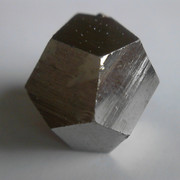 by Phaethon Sun Oct 27, 2019 2:55 pm
by Phaethon Sun Oct 27, 2019 2:55 pm
The irregularity of the crystal appears to be in the distances of the faces from the centre of symmetry. The crystal does appear to be well formed in a particular orientation. Let a vertical co-ordinate axis be called the z-axis, and the horizontal axes be called the y-axis and x-axis.
MirrorsThe faces of the best mirrors are vertical faces. Their normals have no vertical component. They face more towards the x-axis than y-axis. The dullest faces are those at the top and bottom of the crystal and have the greatest horizontal aspect of the faces. Their normals are in the xz-plane and directed closer angularly to the z-axis. The remaining faces are intermediate for mirror and slope. The normals of these faces are in the yz-plane and closer to the y-axis.
StriationsThe vertical faces have vertical striations. The other faces have horizontal striations. On the top and bottom faces, the striations are aligned with the y-axis. On the faces facing a direction in the yz-plane, the striations are aligned with the x-axis.
EdgesBetween the vertical faces are vertical edges, aligned with the z-axis. Between the top and bottom faces are horizontal edges aligned with the y-axis. Between the remaining faces are horizontal edges aligned with the x-axis.
AnglesIt was difficult to measure angles accurately without proper equipment.
Surface Face Angles: These were examined using a protractor. There are at least two sizes of angles between edges on the faces. Angles between edges neither of which is aligned with a co-ordinate axis are about zot four tau radians. The obtuse angles having one arm aligned with a co-ordinate axis are smaller.
Dihedral Angles: These were inspected visually and are roughly a third of a turn. Attempt was made to calculate them using distances between vertices measured using the ruler of calipers and a compass fitted with two needles. The main error is from deciding where the vertices on the crystal are. However, a very small error, of say a few square dozenths of a centimetre, in the distances could lead to large errors, of a few per gross tau radians, in the angles calculated. Calculation of the dihedral angles statistically using many measurements may produce a reasonably good estimate, although this study would be time-consuming.
It would be interesting to compare the inclinations of the faces to those in the pyritohedron of the Weaire–Phelan structure.
NomenclatureFor a dozenist, writing the word dodecahedron feels strange. There has been a proposal for naming of polyhedrons dozenally.
Referenceshttps://en.wikipedia.org/wiki/Dodecahedron#Pyritohedronhttps://en.wikipedia.org/wiki/Weaire%E2%80%93Phelan_structurehttps://dozenal.forumotion.com/t20-dozenal-nomenclature-of-geometrical-figures










» Dozenal Number Words from Metric Prefixes
» Dozenalizing Metric
» Myon Dozenal Nomenclature
» Information per Area of Numerical Forms
» Denominational Dozenal Numerals
» Proto-Indo-European Numbers
» Radix Economy for Alternating Bases
» Graduation Subdivisions